If you're seeking to bring wealth into your life using Feng Shui, the first step is to discover your Feng Shui wealth areas and corners. You may already be familiar with a few wealth areas in your home, but in this article, I will introduce you to five different approaches to finding your Feng Shui wealth areas. Each method may provide a different answer, and by the end of this article, you'll understand the significance of each.
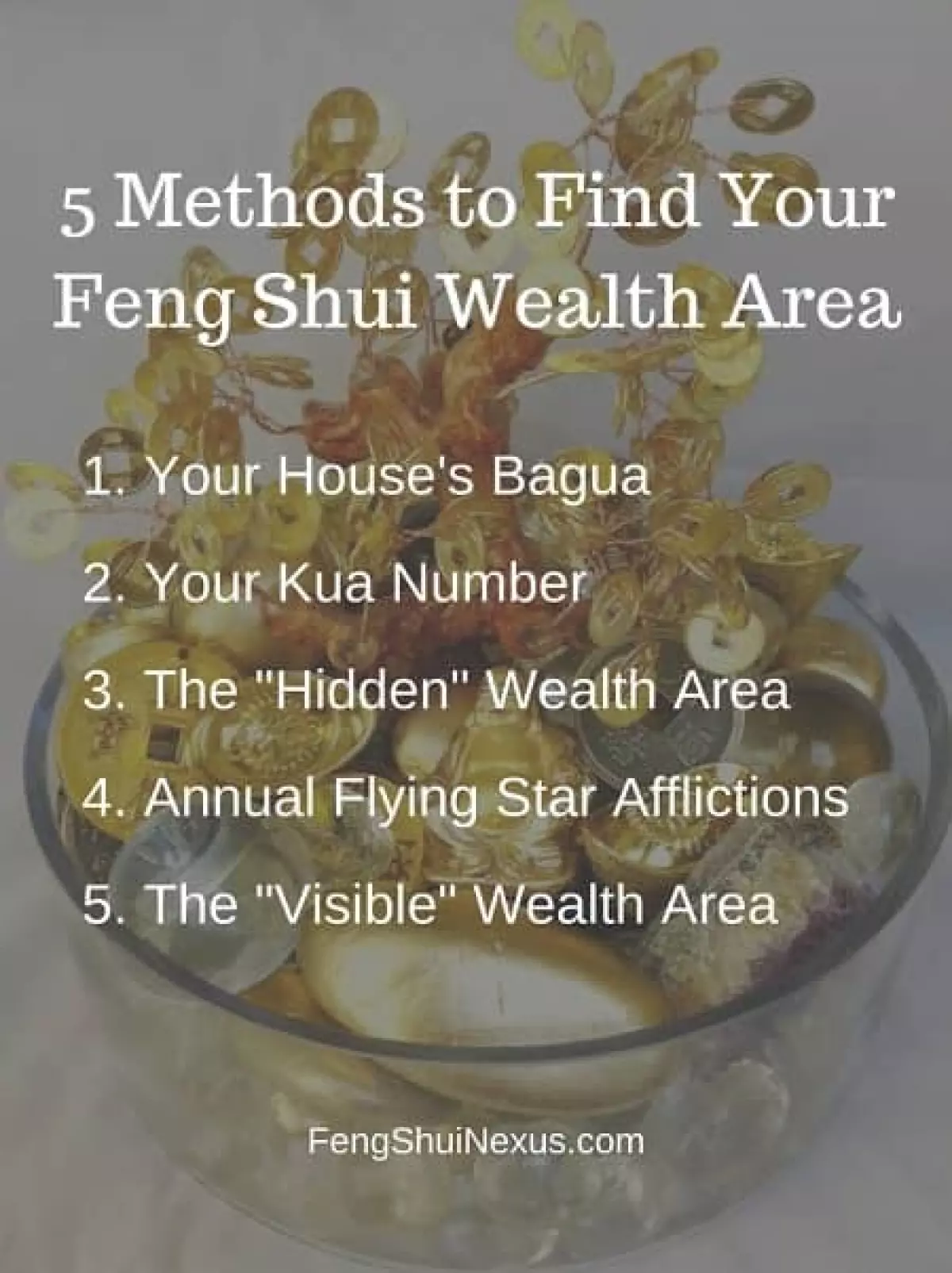
But before we dive in, let me manage your expectations. It's essential to understand that finding the wealth area is just the first step. What you do with that area and how you activate it using Feng Shui wealth formulas is a whole other topic. It can get quite complicated, which is why I always recommend consulting with a Feng Shui expert to guide you through the process.
It's also important to note that wealth in Feng Shui doesn't solely translate to money in your pocket, although it can sometimes manifest that way. Traditionally, Feng Shui aims to bring abundance and prosperity to all aspects of life, including agriculture and social relationships. So wealth can encompass an abundance of life's necessities, such as food, clothing, and strong social connections.
Now that you have this understanding, let's explore the most popular method that many people are already familiar with.
Method #1: Wealth Sector Based on the Bagua
You may already know that the Feng Shui wealth area is located in the Southeast based on the Bagua. However, it's important to note that the Southeast area represents more than just money. It symbolizes prosperity and abundance in life. Different Bagua representations may vary slightly, some showing "Wealth & Prosperity," while others simply show "Money."
To find the wealth area in your home, divide your floor plan into nine sectors, similar to the image shown below:
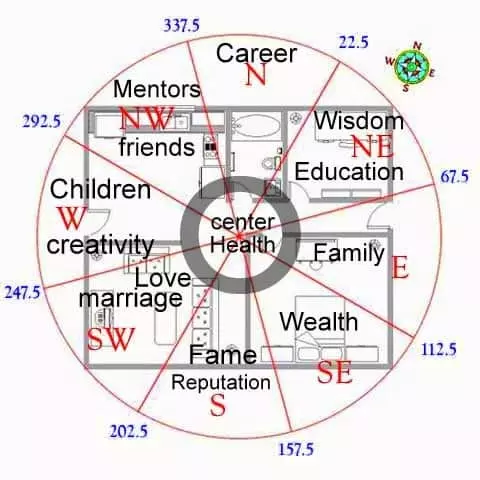 The basics of a Feng Shui Bagua.
The basics of a Feng Shui Bagua.
If your floor plan is a perfect square, locating the Southeast corner is straightforward. That sector will be your Feng Shui wealth area based on the Bagua. However, if your floor plan is rectangular, you'll need to search for the Southeast corner or area of the house. Sometimes, dividing the floor plan like a pie, as shown below, can be helpful:
 Feng Shui Bagua applied onto a floor plan.
Feng Shui Bagua applied onto a floor plan.
If you find this process confusing or have specific questions, seeking guidance from a Feng Shui expert is highly recommended.
Missing Wealth Area Based on the Bagua
It's possible that your wealth area is missing. This can occur if your floor plan is oddly shaped, concaved, or missing a section in the Southeast. Take a look at the sample floor plans below:
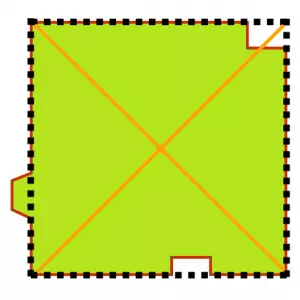 Although directions are not drawn, you can see that the floor plan above is missing a whole complete section in the top right corner. That’s what a missing section looks like.
Although directions are not drawn, you can see that the floor plan above is missing a whole complete section in the top right corner. That’s what a missing section looks like.
If the Southeast area is completely missing, applying cures can be more challenging. In such cases, consulting with a Feng Shui expert is crucial to remedy the situation and enhance your home's Feng Shui.
If the Southeast area is present but weak, meaning it only has a surface area missing, you can boost its energy with elemental cures. Adding water elements such as blue-themed colors or wavy objects can help activate the Wood element energy that the Southeast area belongs to.
It's important to note that a missing wealth area can also occur with the other methods mentioned in this article.
Method #2: Wealth Areas Based on Your Kua
Your Kua number represents your unique Feng Shui requirement. It is calculated based on your year of birth using the lunar calendar, with the cut-off date around February 4th or 5th each year. There are many free online Kua number calculators available. Once you know your Kua number, you can determine your four lucky directions, which include your wealth areas.
Here's an example of someone with Kua #8:
 The Kua for a person with Kua number 8.
The Kua for a person with Kua number 8.
For someone with Kua #8, their wealth areas are the Southwest (Prosperity) and Northwest (Tien Yi). To apply the Kua onto your floor plan, start by finding the center of the house. This can be done by identifying the intersection point of two diagonal lines drawn across the four corners of your house.
 The central point of the house is the intersection of two diagonal lines drawn across the four corners.
The central point of the house is the intersection of two diagonal lines drawn across the four corners.
Once you've determined the central point, divide your floor plan into eight cardinal directions. This is similar to cutting a pie into eight pieces, with the eight cardinal directions taken into consideration. In cases where finding the center of the house is challenging due to an extraordinary floor plan, seeking guidance from a Feng Shui expert or referring to specialized resources can provide clarity.
Understanding why the Prosperity and Health areas are considered wealth sectors is crucial:
- Prosperity (Shen Chi): Translated as "growth Chi," this direction is associated with advancing your career and starting a business. It provides the energy and motivation to achieve your goals. If you're aiming for financial success, this area will boost your willpower and mental strength.
- Health (Tien Yi): Translated as "heavenly doctor," this direction is linked to your well-being and indirectly connected to wealth. It ensures you have the physical strength and wellness needed to achieve your goals.
One commonly overlooked area is the Stability area (Fu Wei). Some experts believe that this area holds hidden wealth potential. Ensuring that this area is free from negative Feng Shui influences can enhance stability and contribute to potential financial gains.
Method #3: Wealth Area Based on the House's Facing Directions
This method focuses on the "hidden" wealth area. In contrast, method #5 explores the "visible" wealth area or corner.
To find the hidden wealth area, you'll need to consider the direction that your house is facing and the floor plan divided according to the nine palaces (as described in Method #1). If you know the house's facing direction, use the chart below to locate the hidden wealth sector:
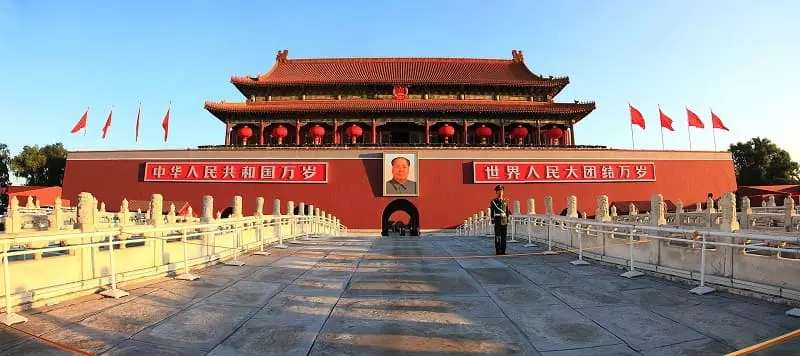 Hidden Feng Shui Wealth Area based on the Home's Face Direction.
Hidden Feng Shui Wealth Area based on the Home's Face Direction.
It's essential to understand that the front door's direction may not always align with the house's facing direction. While the front door's direction often corresponds to the house's facing direction, there are instances where they differ.
 Where is the front door of this house?
Where is the front door of this house?
Some Feng Shui experts emphasize the challenge of determining a house's true facing direction. Factors such as the surrounding environment, home architecture, and road shape should all be considered. However, in many cases, the house's facing direction can be determined by intuition. When you look at your house from the street, does it appear to face towards you? Can you identify where its "face" would be if the house were a human? These are helpful indicators in identifying the house's facing direction.
Another approach is to locate the backyard. Typically, the opposite side of the backyard indicates the "face" of the house.
It's worth noting that certain factors, such as the front door opening inward or outward or furniture placements within the home, can influence the position of these areas. Consulting with a Feng Shui expert will provide greater clarity when identifying your wealth areas.
Method #4: Wealth Sector Based on Annual Flying Stars
Time plays a significant role in Feng Shui, and the annual afflictions focus on the aspect of time. Based on Xuan Kong Flying Star Feng Shui, the annual afflictions represent the constant cyclical changes in nature. Similar to astrology, these annual afflictions bring different energies to different sectors each year.
One crucial star to look out for is Star #8, known as the Prosperity Star. Considered the luckiest of all stars, it represents fortune, nobility, and health. It's important to note that, just like the Southeast area in Method #1, this star signifies prosperity and abundance in life, not just money in your pocket.
Each year, Star #8 lands in a different sector of your home. For example, in 2017, Star #8 was located in the East. Therefore, the East area, based on the nine palaces, becomes your wealth area for that year.
Method #5: "Visible" Wealth Corners Based on Your Front Door
Although not traditionally part of Classical Feng Shui, this method has gained popularity in urban living environments. It focuses on the "visible" wealth corner.
The front door serves as the gateway for auspicious Qi to enter your home. This Qi includes energies that bring wealth and prosperity. To identify where this auspicious Qi gathers, stand at your front door and look for the adjacent corner, as shown below:
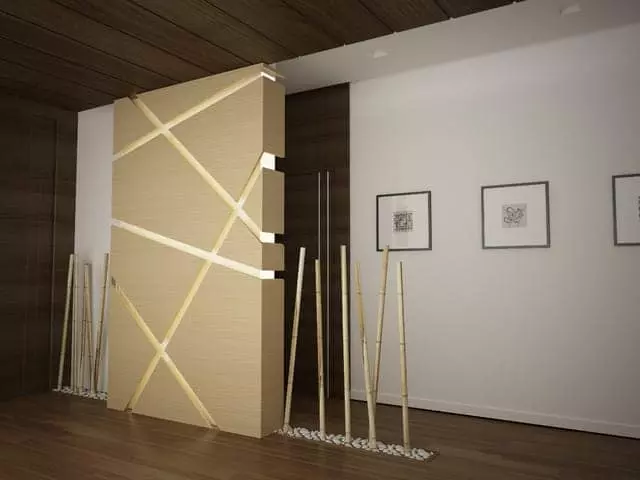 The visible Feng Shui wealth area based on the front door.
The visible Feng Shui wealth area based on the front door.
The term "visible" refers to the fact that this corner should be visible to you once you enter the house through the front door. Feng Shui experts may differ in their interpretations of this corner's precise location. Some believe it should be the first corner you see, while others argue that it is the corner at the end of the house.
From my perspective, both interpretations hold merit. If you follow the principle that this corner accumulates Qi, then both the first corner and the corner at the end of the house are possibilities, depending on your home's layout. Visualize the flow of Qi as it enters your house through the front door, similar to the way air flows.
It's worth mentioning that other factors, such as the front door's direction, whether it opens inward or outward, and furniture placement within the house, can also influence the position of these areas. Consulting with a Feng Shui expert will provide further insights when identifying your wealth areas.
What If I Have Multiple Wealth Areas?
Following these methods, it's possible that you may identify multiple wealth areas. Some may have five or more, while others may only have one or two. Does this variation hold any significance?
If you have multiple wealth areas, each plays a role in the wealth and prosperity you experience in life. Observing and correlating what happens in these areas with your life's events will help you understand their individual influences. If you find that you have only one or two wealth areas after applying all these methods, do not worry. It simply means that those areas have a stronger impact on your wealth and prosperity luck.
In fact, overlapping wealth areas can simplify your Feng Shui wealth adjustments. Instead of making adjustments throughout your home, you can focus on specific sectors. Additionally, overlapping wealth areas may amplify results, making them more powerful.
For example, if your home faces Northwest with the hidden wealth area in the Southeast, your Kua number is #1, and the current year has Star #8 located in the Southeast, taking care of the Southeast area can significantly impact your luck. It's worth noting that the Southeast area is also the Wealth and Prosperity area based on the Bagua.
Conclusion
Before embarking on a Feng Shui journey to attract wealth, it's essential to know where to start. Finding your wealth areas and corners is just the first step. The next step is to explore ways to enhance the energy in those areas or activate them according to Feng Shui principles.
However, it's crucial to understand that Feng Shui is not a magic solution, and simply placing a lucky charm or a three-legged toad randomly will not bring results. The process can be intricate, especially when dealing with unique or extraordinary floor plans and designs. In such cases, seeking the assistance of a Feng Shui expert or investing in courses and training to learn Feng Shui correctly is highly recommended. These resources can provide additional wealth setup formulas, such as Water Dragon wealth or Five Ghosts Carry Wealth.
If you have experience using Feng Shui for wealth, I'd love to hear about your journey. Share your thoughts and experiences by leaving a comment below!











